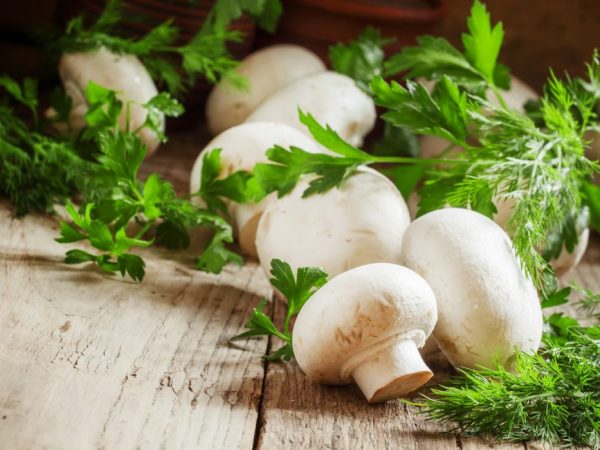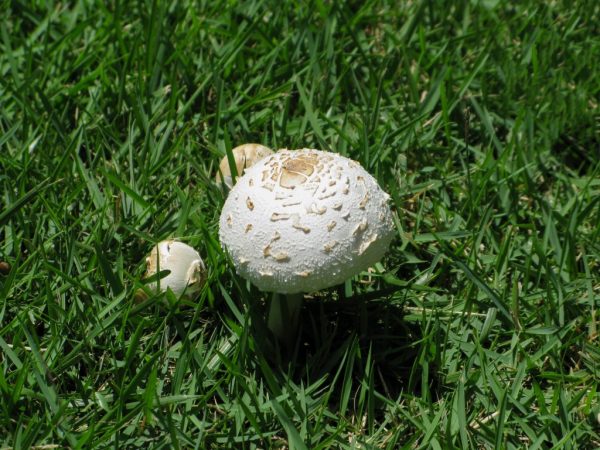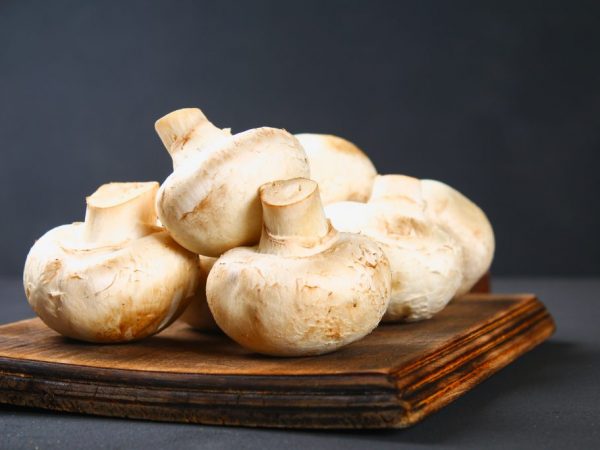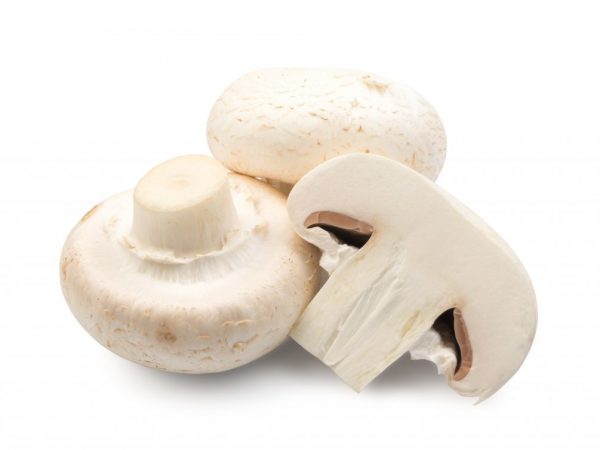Description of champignon mushrooms
Today champignon mushrooms are on the shelves in almost all grocery stores in our country. This is the most popular species, which is not only harvested in the wild, but also grown on mushroom farms, and some are able to harvest on their own balcony or windowsill.
- General characteristics of champignons
- Habitat
- Varieties of champignons
- Common types of champignons
- Champignon real
- Forest Peppers
- Field mothers
- Coppice peppers
- Crimson peppers
- August peppers
- Doubles and false mushrooms
- Useful properties of bakers
- Contraindications to the use of champignons
- Features of growing breadcrumbs at home
- Planting material and soil
- Shelf life
- Conclusion

Description of champignon mushrooms
General characteristics of champignons
It is difficult to confuse common champignon, which belongs to saprotrophs, with any other mushroom. Small mushrooms resemble small balls of white, beige or brownish color. Their hat is tightly pressed against the leg. As the peppercorn (the second name of the mushroom) grows, the edges of the cap move away from the stem, and its shape becomes flat-rounded or flat. This type of mushroom is not large. The diameter of its cap varies within 5-10 cm.And only in certain varieties the diameter of the cap can exceed 10 cm.An average of 20 g. But there are specimens weighing 30-35 g. peppers for a long period of time.
It is interesting that champignons do not form mycorrhiza, being exclusively saprophytes.
Fresh mushrooms are dense in structure. Their flesh is colored snow-white or white-yellow. Sometimes there is a pink tint. In the place where the leg goes into the cap, there is always a ring. It can consist of 1 or 2 layers and resembles a small skirt. This type of mushroom is popular for its pronounced aroma, which gives a savory taste to even a simple dish.
Habitat
Common champignon loves fertile soil, grows nearby dung heaps. Mountainous terrain is preferred for him. It is not uncommon to be found in forests or in the steppe. Steppe species are less common than others. People have learned to grow large and tasty champignon mushrooms in their summer cottages. There are entire farms where peppers are grown hydroponically.
Varieties of champignons
There are several classifications:
- According to the presence of rings: two-ring and one-ring mushrooms are distinguished;
- By habitat:
- Forest soil saprophytes: forest mushroom, w. coppice.
- Soil saprophytes of open spaces devoid of vegetation: double-pore champignon, w. two-ring, or w. sidewalk, sh. semi-shod.
- Herbophiles (only among herbs): common champignon, w. August.
- Growing in open spaces among grasses and in forests: field champignon, w. elegant.
- Desert (including halophiles): Bernard's champignon.
Each type of champignon has slight external differences and a special taste. There are also differences in the structure and color of the pulp.
All of the above varieties are edible. But inedible and poisonous mushrooms are found in nature, which the mushroom picker must be able to distinguish from edible ones. There are also double mushrooms or false champignons, which are similar in description to the common champignon. If you look closely, it is easy to find characteristic differences.
Common types of champignons
The most common are real or common champignons, forest, field, coppice, August and dark red.
Champignon real
Peaches of this type are also called meadow. Their height is 5-7 cm.Maximum height of meadow chickens is 10 cm.This variety belongs to large mushrooms, the diameter of the cap of which varies from 10 to 15 cm.In young peppers, the cap has the shape of a hemisphere, and its edges adjacent to the leg are tight wrapped inward. With age, their caps acquire an almost flat shape. The diameter of the leg does not exceed 2 cm. The flesh of this variety of bakeries is painted in a snow-white color. At the site of the cut, the pulp is oxidized in air and acquires a delicate pinkish tint.
Forest Peppers
It is better to look for fresh champignons of this type in coniferous forests. Forest peppers are much less common in deciduous forests. They grow in dozens of specimens together, uniting in large groups. The cap of this champignon, on which there are small scales, looks like an egg or a bell. As they grow, their caps become almost flat. The leg height does not exceed 6 cm.

There are small scales on the mushroom cap
The forest peppers are dyed light brown. The scales have a more intense color than the main body of the fungus. Most often they are located closer to the center of the cap and less often to its edges. Inside there is a snow-white pulp. The cut site becomes reddish.
Field mothers
Champignons of the sidewalk species, two-ring or field, grow both in the mountains and on the plains. Wildfathers cannot be seen in deciduous forests. The hat initially resembles a bell with slightly curved inward edges. As the mushroom grows, the cap becomes more and more flat, but a small tubercle remains on the central part. A two-ring champignon is painted in white or cream color. On the surface of the cap, sometimes there are scales that have a silky structure and are painted in a white-yellow color. With age, the cap changes color to ocher.
Field peppers are valued for their dense and fleshy flesh and good taste. The taste of mushrooms has anise notes. The cut peppers take on a yellowish tint.
The properties of field mushrooms are attractive, but you need to be careful when picking this type of mushrooms, because it bears similarities to some poisonous mushroom species.
Coppice peppers
Fresh coppice mushrooms are valued for their aniseed aroma, which persists even after heat treatment. Coppice or slender peppers grow both in groups and singly. In young bakeries, the hats are shaped like an egg. Over time, they straighten and become flat-rounded or resemble an athlete's throwing disc. The diameter of the caps of fresh champignons of this species usually does not exceed 10 cm.
The caps of young mushrooms are colored in a delicate creamy color, which darkens over time, gradually acquiring a light brown hue. There are no scales on the caps, and the surface of the mushrooms is silky to the touch. The delicate body of the mushroom, when pressed, changes color, acquiring a yellow tint.
Crimson peppers
This species lives next to deciduous trees. The color of this type of champignons is easy to guess from their name. In young mushrooms, the caps are shaped like a cone with a trimmed top, and under the cap, plates of a delicate structure turn pink. As they grow, they acquire a flat-oval shape.
Young spring brown mushrooms may have a smooth cap surface.Over time, cracks appear on it, in place of which scales form. The legs are painted gray, which is in harmony with the brown caps. The height of an adult mushroom does not exceed 10 cm.
The name of the mushroom is due to the fact that the snow-white pulp instantly turns red at the cut site, an unusual smell appears.
August peppers
These champignons with a white stem and a light brown cap are demanding on environmental conditions. They grow only in temperate regions. August peppers grow next to coniferous and deciduous trees, occasionally they are found in park areas. In small August mushrooms, the cap resembles a ball, which, as it grows, straightens and becomes flat-rounded. This type of bakeries usually grows in colonies. They are often found near large anthills.
Fresh August champignons have a huge number of small scales on the cap, which are painted in a brick color. The color of the cap itself is brown. At the same time, the leg is painted white. These are large organisms: the diameter of the cap varies from 13 to 15 cm. In cooking, this type of mushroom is prized for its characteristic almond aroma, which is revealed during heat treatment.
If you cut the mushroom, the flesh will darken or acquire a yellowish tint. These peppers ripen at the end of summer. The fruiting period is 3 months.
Doubles and false mushrooms

Champignons have many poisonous counterparts
Mushrooms that are deadly for humans, which are similar in appearance and structure to peppers, are the white fly agaric and pale toadstool. Most of all, they look like coppice peppers. It is easy to recognize poisonous mushrooms among edible ones by the shade of the pulp at the cut. In poisonous mushrooms, it does not oxidize and retains its previous color. An adult edible mushroom changes the color of the plates on the inside of the cap. In poisonous mushrooms, it remains unchanged. The presence of a volva surrounding the swollen base of the leg of a pale toadstool or a white fly agaric is another difference between poisonous mushrooms and ovens that do not have it.
The inedible varieties of peppers are ginger, or yellow-skinned and flat-lobed mushrooms. An incision is made to determine if the cookie is inedible. The cut becomes bright yellow or orange, which are not typical of edible varieties. Also, the mushroom exudes a smell that is similar to the smell of medicines (often said "pharmacy"). If you put an inedible fresh champignon in water, the smell will become more pronounced, and the body of the lady will turn yellow. The water will also turn yellow. If you boil an edible mushroom, the water will change color a little.
Irina Selyutina (Biologist):
For yellow-skinned champignon, or w. reddened is characterized by the presence of a swelling at the base of the leg, which is not the case in edible representatives of the Champignon genus. According to the degree of toxicity, this species is classified as a medium-poisonous mushroom. This means that when it is consumed in food, a rather serious disorder of the gastrointestinal tract may occur. Unfortunately, to date, the active ingredient in yellow-skinned champignon has not been established. But, despite this, w. yellow-skinned is used in folk medicine, due to the presence of natural antibiotics in its fruiting body.
For your information. When picking wild mushrooms, the mushroom picker needs to be very careful, because yellowing on the stem or cap of the yellow-skinned champignon does not appear immediately, but after a while.
The flat-headed champignon is another mushroom that belongs to the Champignon family and is poisonous. It is a lamellar mushroom with a scaly cap. It differs from its edible counterparts in the family by a pungent unpleasant odor. Yellowing champignon is also dangerous. It is distinguished by its large size (the diameter of the cap exceeds 15 cm). When cut, the yellowing mushroom turns bright yellow.Poisonous champignon, which is called variegated, is rare.
Champignon is not a tubular mushroom, unlike some poisonous varieties. On this basis, edible species are also distinguished from inedible ones in the forest (there are more poisonous lamellar species than tubular ones).
Fresh or boiled false champignons contain the same amount of toxic substances that cause disruption of the digestive tract.
Useful properties of bakers
Peppers are rich in protein, so they can be a meat substitute for vegetarians or during a fast. In addition to protein, they contain amino acids necessary for the normal functioning of the body, minerals and carbohydrates. Peppers are also popular with nutritionists. Their indicators KBZHU (calorie content, the ratio of proteins, fats and carbohydrates) are as follows: calorie content is only 270 kcal per kg of product, and the glycemic index is 15 units. With such a low calorie content, bakers have a high energy value. Few foods on the calorie table are so low and do not have such significant energy value.
Fresh, boiled and baked product has a low calorie content. Dried peppers contain 2-2.5 times more calories.
Also, peppers hold the record for the content of B vitamins. Medicine knows about the presence of antioxidant properties in them and folic acid necessary for women's health. They are also rich in fiber and useful for high cholesterol levels.
Irina Selyutina (Biologist):
In addition to the above, it is necessary to point out that the chamignons contain:
- high amounts of vitamin D2which prevents the development of osteoporosis;
- pyrocatechol compound (phenolic compound with a characteristic phenolic odor), which has a hemostatic effect;
- omega-6 fatty acid, which is an excellent prophylactic against atherosclerosis, improves bone nutrition and stops the development of many inflammatory processes.
By the way. A 2009 study on the occurrence and development of breast cancer, in which 2018 women took part, showed that the introduction of mushrooms into the diet stops the development of oncological processes. You can reduce the incidence of breast cancer by 90% if you eat champignons and green tea regularly.
At the moment, there is a debate about the benefits of eating raw chicken. Of course, a fresh product contains much more nutrients than one that has undergone heat treatment. But the organism, during the cultivation of which insecticides were used, will easily be poisoned. It is better to heat the purchased products. Cooked bakers taste much better.
When heat-treated, the mushrooms should be cut rather than cooked whole, this will help determine if the organism is edible. And only then it can be cooked, fried or extinguished. Poached mushrooms are tasty, i.e. fried on minimum heat in butter for 5-7 minutes. Cooking and stewing does not exceed 15 minutes.
Peppers are digested for a long time, which is why you should not use them at night.
Contraindications to the use of champignons

Mushrooms are not advisable for stomach ulcers
With pancreatitis, gout and gastritis, one should refrain from eating chives. Mushrooms are not recommended for stomach ulcers. If these diseases are not in the stage of exacerbation, then the use of mushrooms in a small amount will not harm the body. It is worth giving preference to dishes that are cooked not in vegetable oil, but in water.
Any mushrooms are an allergen, therefore, they are recommended to be consumed in moderate doses. And allergy sufferers should first find out if they have an intolerance to the constituent mushrooms. Peppers are also contraindicated during lactation.
Their use is not contraindicated for diabetics. It doesn't matter what type of diabetes we are talking about.Peaches are also used for cancer. If we talk about age restrictions, then mushrooms are not recommended for young children. It is better to introduce peppers into the diet of children at the age of 4-6 years. This is due to the fact that chitin in mushrooms is poorly absorbed by the child's body.
Features of growing breadcrumbs at home
At home, champignons turn pink in the garden a month after planting, their growth is very fast. To grow a garden variety of champignons, you will need a place in your garden plot, planting material and special soil. Peppers are also grown in a basement equipped with containers with soil, artificial lighting and a ventilation system. When grown in a basement, the crop will be harvested all 4 seasons.
Peppers prefer to grow in greenhouses. It is difficult to get a good harvest outdoors. If you grow myceliums outdoors, then the conditions should be as close as possible to the habitat habitual for ovens.
Planting material and soil
Even large mushrooms can be grown at home. Caring for the "mushroom meadow" will not take much time. Peppers feed on substances extracted from the soil. As planting material, you will not need seeds, but spores. You can get them from the cap (mushrooms from the supermarket will not work), but it is better to purchase a special mycelium. To get mushroom spores, you need to choose good and not old mushroom caps, rinse them, grind them and place them in water for several days. Then strain through cheesecloth. To propagate the peppers will turn out by dividing the myceliums.
Whether grown in a vegetable garden or basement, the mycelium nutrient mix should consist of manure, straw or coconut fiber and organic additives.
It is not difficult to set up production on a mushroom farm. But it will take a lot of money to equip it.
On a note. Champignon varieties with the name "Riddle", as well as Brazilian, mini and double-pore champignon have good yields.
Shelf life
The shelf life of bakers is short. Within a few days they turn black and wither. Storage in a refrigerator or cellar will briefly extend the shelf life. Also, these mushrooms are canned for the winter. Sterilized chives can be stored for up to 24 months. Another option for the winter is frozen peppers. Peel the mushrooms before freezing. It is also advisable to remove the black plates, leaving only the white part. Then the mushrooms must be washed under running water for 5-6 minutes. There are different ways of preservation.
Dishes made from bad bakeries are bitter and have a mild mushroom aroma. Expired and overripe mushrooms with black plates are not worth eating. They cause disruption of the digestive tract and can provoke poisoning. The missing peppers taste bitter. Necessarily neglected and wormy specimens. Fully opened peppers are close to overripe. Before cooking, mushrooms should be thoroughly cleaned of adhering dirt, remove the skin from the cap. Small mushrooms do not need to be cleaned, but you should treat them with boiling water or rinse them under running hot water.
Peppers of any age are suitable for processing, but young specimens have a softer taste.
Conclusion
In Russia, with a sufficient amount of rains, peppers appear in the spring. White mushrooms look very attractive. The last crop is usually harvested in late autumn. You should not take spoiled mushrooms with black plates. Peppers gather in ecologically clean areas, away from the roadway, then the use of these organisms is not so dangerous. If the mushroom turns yellow in the cut, it is thrown away.
The cakes go bad quickly. Those specimens that do not go into cooking should be washed in the near future, and then closed in any way or dried. Pre-peeled peppers are dried without adding salt and other spices.It is better to choose peppers of the same size for preservation (so they are evenly saturated with marinade).
Growing mushrooms at home, per season from 1m2 they collect 4-6 kg of a quick harvest, and sometimes 10-12 kg. From the first to the second harvest, no more than 9-10 days pass. For a season with such a yield, it will be possible to collect about 100 kg. Receiving a crop of 100 kg, the mushroom grower is able to organize a small business and a farm.



